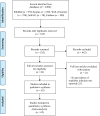Snakebite-Associated Infections: A Systematic Review and Meta-Analysis
- PMID: 38507793
- PMCID: PMC11066359
- DOI: 10.4269/ajtmh.23-0278
Snakebite-Associated Infections: A Systematic Review and Meta-Analysis
Abstract
Snakebites still constitute a significant public health problem in developing countries and are considered a neglected tropical condition by the WHO. Snake accidents are associated with substantial morbidity and mortality and may produce secondary complications, such as severe infections. The objective of this systematic review was to determine the prevalence of snakebite infections and characterize the bacteria isolated from these infections. A systematic literature review in five databases was carried out to assess the prevalence of snakebite infection. A meta-analysis was performed using a random-effects model to calculate the pooled prevalence and 95% CIs. Cochran's Q test and the I2 statistic were used to assess between-study heterogeneity. The pooled prevalence of infection due to snakebite was 27.0% (95% CI: 22.0-32.0%), with high heterogeneity among studies (I2 = 99.7%). The prevalence was higher in Asia (32%) than in the Americas (21%). Snakebite infections required surgical interventions in 68% (95% CI: 37.0-98.0%). The leading group of pathogens identified corresponded to Gram-negative bacteria (63%), particularly Morganella morganii (32%), but also, Gram-positive cocci (40%), especially Enterococcus spp. (23%) and Staphylococcus aureus (15%). However, multiple other pathogens, including anaerobes, were found. A high prevalence of snakebite-associated infection has been described, primarily due to M. morganii, with the corresponding implications for empirical therapy. Rational use of antimicrobials is recommended, and this should guide initial empirical treatment. Moreover, isolation and identification of the possible bacteria present in snakebite wounds is recommended in all cases to confirm or rule out associated infection.
Conflict of interest statement
Authors’ contributions: D. Katterine Bonilla-Aldana: conceptualization, investigation, formal analysis and writing—original draft. Jorge Luis Bonilla-Aldana: conceptualization, investigation, formal analysis and writing—original draft. Juan R. Ulloque-Badaracco: methodology, formal analysis and writing —original draft. Enrique A. Hernandez-Bustamante: methodology, formal analysis and writing—original draft. Ali Al-Kassab-Córdova: methodology, formal analysis and writing—original draft. Esteban A. Alarcon-Braga: methodology, formal analysis and writing—original draft. Abdelmonem Siddiq: methodology, formal analysis and writing—original draft. Vicente A. Benites-Zapata: methodology, writing—review and editing, visualization and supervision. Alfonso J. Rodriguez-Morales: conceptualization, investigation, writing—review & editing, visualization and supervision. Jose A. Suárez: conceptualization, investigation, writing—review and editing, visualization and supervision.
Figures
References
-
- Benítez JA, Rifakis PM, Vargas JA, Cabaniel G, Rodríguez-Morales AJ, 2007. Trends in fatal snakebites in Venezuela, 1995–2002. Wilderness Environ Med 18: 209–213. - PubMed
-
- Patiño-Barbosa A, Herrera-Giraldo A, Lozada-Riascos C, Paniz-Mondolfi A, Suárez JA, Rodríguez-Morales A, 2019. Snakebites mapping in municipalities of the Coffee Triangle Region in Colombia using geographic information systems (GIS). RevPanam Enf Inf 2: 14–20.
-
- Cascio A, Bosilkovski M, Rodriguez-Morales AJ, Pappas G, 2011. The socio-ecology of zoonotic infections. Clin Microbiol Infect 17: 336–342. - PubMed
Publication types
MeSH terms
Substances
LinkOut - more resources
Full Text Sources
Miscellaneous




